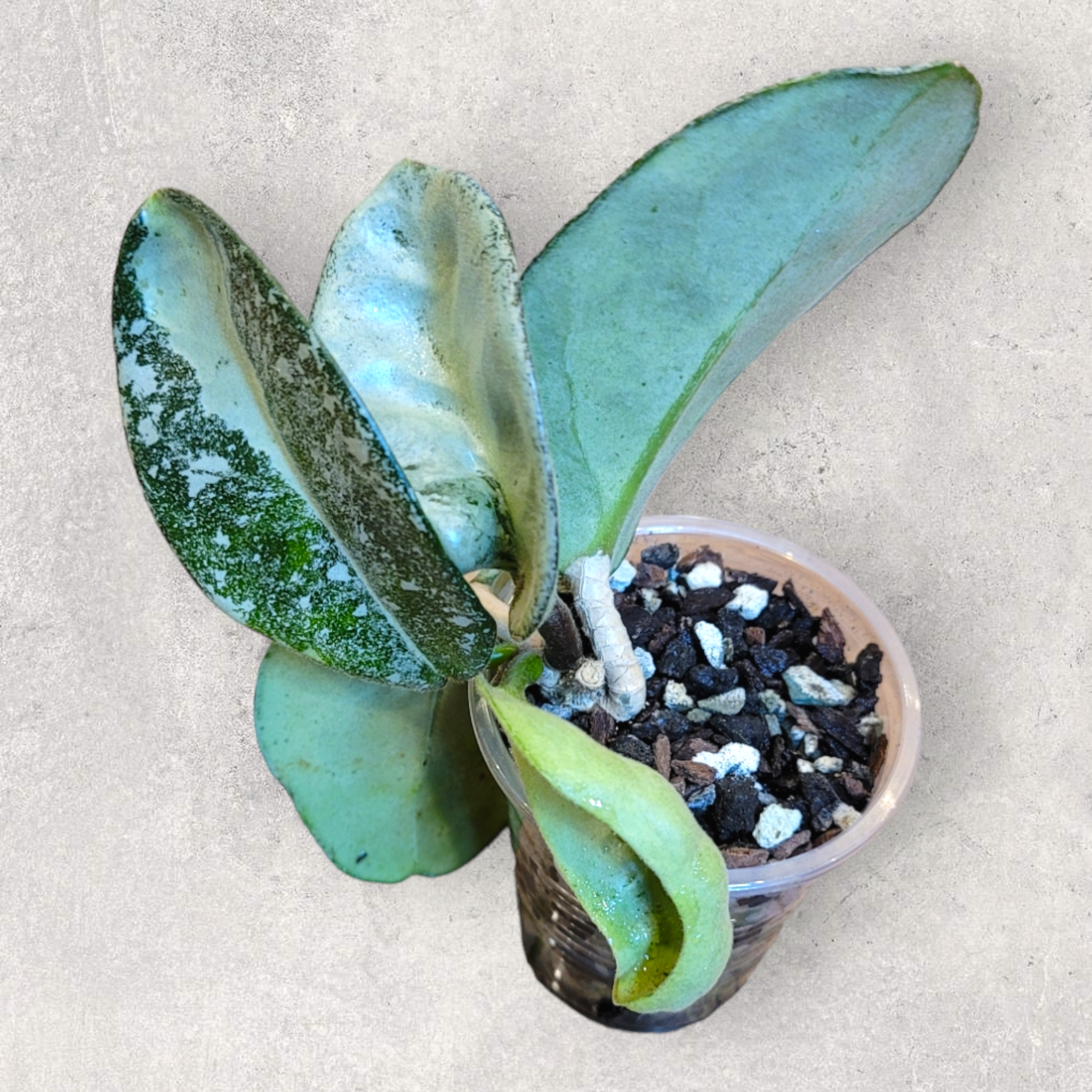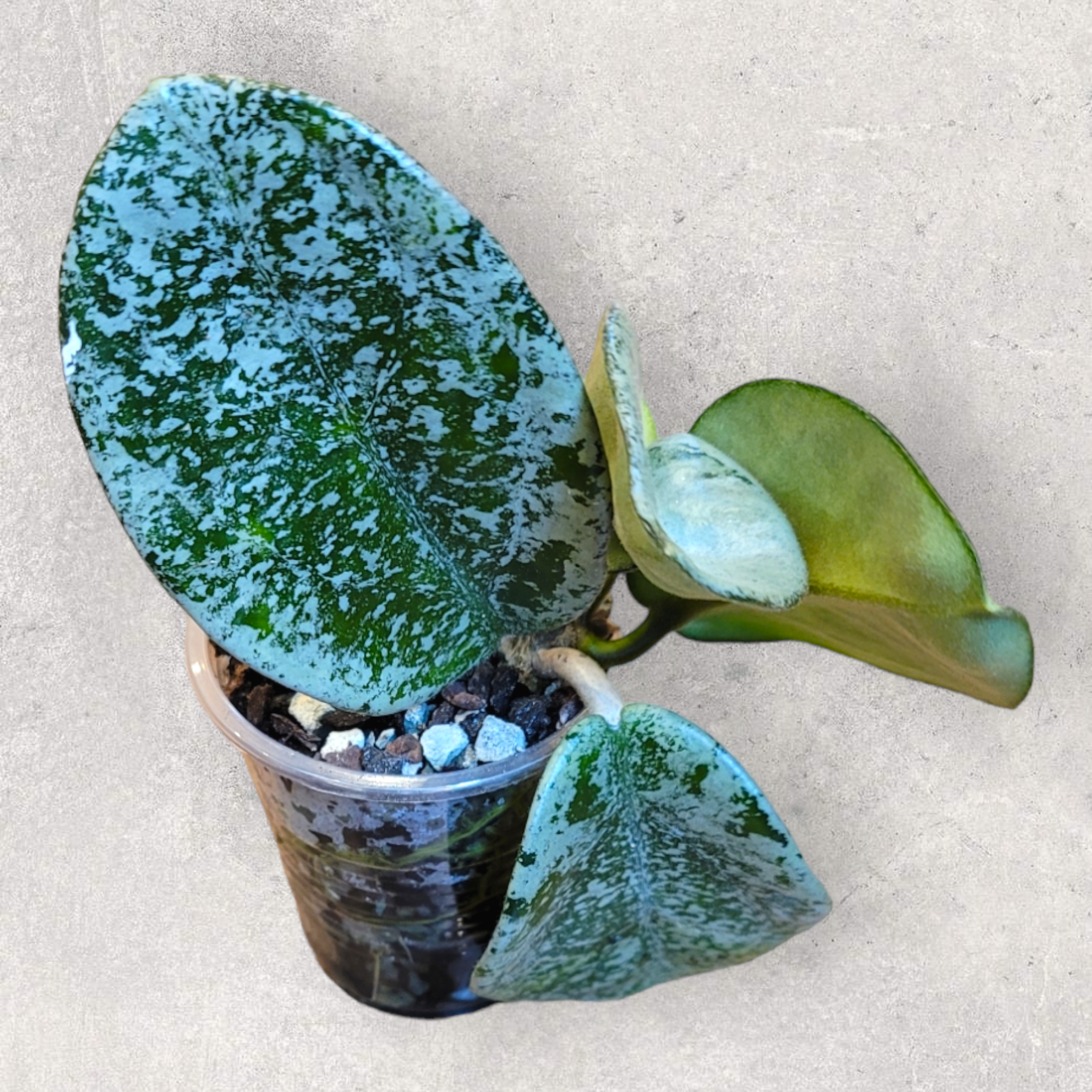
Hoya Carnosa 'Nova Ghost'
The Hoya carnosa 'Nova Ghost' has the same easy maintenance requirements as a regular Hoya carnosa and is a rare and stunning silver Hoya. This is actually a reverted version of the even more coveted Hoya carnosa “Argentea Princess.”
Hoya carnosa produces smooth, pale gray, bare shoots that are barely succulent and twine and climb. The stalked perennial leaves have stems that are between 1 and 1.5 cm long. The blade may be longitudinally oval, wide oval, or heart-shaped. The leaves have a fleshy, slightly succulent texture and a glossy, waxy surface. The ovate or elliptical leaves have a petiole that is about 1-1.5 cm long and 3-5 cm wide. Fruits are spindle-shaped and range in size from 6 to 10 0.5 to 1.5 cm.
Flower
Numerous hanging or more upright flowers are arranged in an umbel to form the inflorescence. The flowers are star-shaped and borne in clusters that resemble tiny wax figurines. They are typically light pink but can also range from near-white to dark pink. The flowers have a fuzzy sheen due to the tiny hairs that cover their surface. They may produce excess nectar that drips from the flowers and has strong scents. The flower crown is whitish to slightly pink in color and has a diameter of 1.5 to 2 cm.
Like the majority of Hoya species, Hoya carnosa produces flowers from specialized perennial peduncles, also known as spurs. These emerge from the axils of the leaves and stem; they may not bear flowers at first, but eventually, buds will appear from the tips of the spurs. These same spurs bear flowers each year, so they shouldn’t be removed.
The plant blooms from spring until late summer; on the same peduncle, it can bloom in 2 to 3 weeks, gradually forming umbels of 10 to 50 tiny star-shaped flowers. The scent has a pheromonal tendency and is nocturnal.

Specifications:
Scientific name: Hoya carnosa
Common names: Nova Ghost
Origin: Australia, India, and parts of southern China.
Flower colour: White to pink
Genus: Hoya
Family: Apocynaceae (Asclepiadaceae)
Kingdom: Plantae
Type:Flowering vine
How to care?
Hoya carnosa 'Nova Ghost'
Hoya carnosa prefers direct light that is bright. It can withstand a little morning or evening light but avoid direct midday sun because the leaves will scorch and turn yellow.
Use a coarse, incredibly well-draining substrate and repot plants at least every other year using a very well-draining soil mixture (see hoya soil). Water thoroughly and let excess run off. Yellowing leaves are a sign of waterlogged soil, which will also cause root rot and eventual death. Never let the plant’s roots stand in water that is still.
Hoya carnosa’s foliage will burn and die if exposed to frost because it is not hardy. It can endure low temperatures of up to 10 °C (50 °F)., but growth is negatively impacted by temperatures that are consistently above 25°C (77°F).

Summary:
- Very easy to maintain
- Requires little water
- Adapts well to its environment
- Thrives in plenty of indirect sunlight and high humidity.
Hoya carnosa 'Nova Ghost' Detail

Light Requirements:
- The Wax Plant can grow in environments with moderate to strong indirect lighting, but it does best in the latter. A plant that is thriving will grow vegetatively and exhibit abundant flowering, which is a goal that most likely meets the expectations of plant enthusiasts.
- If a plant is exposed to direct sunlight for a few hours in the morning, it will not harm it; on the contrary, it will benefit from it. However, it suffers greatly from exposure to midday sunlight.
- Artificial light sources can produce excellent results in indoor spaces with little to no natural light. For instance, fluorescent lamps with a luminous flux above 3230 Lumen can be used to achieve this (lm). The lamps should give the plant 12 to 16 hours of light, followed by complete darkness for the remaining eight hours of the 24-hour period.
- The Wax Plant should be placed inside the home close to or next to a window that is covered with curtains. For the southern hemisphere and the northern, the proper window orientation is north.
- The Hoya carnosa seems like a great choice for a very bright bathroom, provided that the exquisite aroma of its flowers only permeates this unique and largely - as usual - strictly private space.
- The most ideal location for Wax Plants, whose climatic conditions allow them to be planted in gardens, is either under a tree or in locations in partially shaded areas of the appropriate environment.

Temperature Requirements:
- Another indoor plant that is primarily native to the tropics is the wax plant. In exposure to temperatures between 18 and 32 °C, it thus feels at ease.
- When cultivated as an ornamental plant outside of its natural habitat, the temperature requirements of the plant change depending on the season and the phase of the day/night cycle.
- Wintertime minimum nighttime temperatures shouldn’t drop below 10 to 12 °C, while maximum daytime temperatures can range from 22 to 24 °C. In addition to other things, at these temperatures, Hoya normally grows during the upcoming vegetative season, and its flowering is encouraged.
- In the summer, a minimum nighttime temperature of 16 to 18 °C and a maximum daily temperature of 24 to 29 °C are advised.
- Hoya carnosa needs exposure temperatures between 0 and -1 °C for minimum values and 34 to 36+ °C for maximum values if it is planted outdoors, whether in a garden or on a landscape.

Humidity Requirements:
- Compared to most indoor plants, the porcelain flower prefers relative humidity levels that are higher. Its favorable growth values range from 40 to 60%, but the closest to the maximum value yields the best results both vegetatively and in terms of boosting flowering.
- However, indoor relative humidity above 50% makes it very difficult for people to live there, while indoor relative humidity below 40% makes it very difficult for the plant itself because it increases the risk of pest attacks, like those from mites, among other things.
- This issue can be resolved in a relatively straightforward manner by altering the microclimate near Hoya. Techniques used to accomplish this and provide the plant with a wetter environment include, among others:
- the routine misting of the vegetation (twice a week)
- utilizing a humidifier
- Placing a shallow plate or tray filled with water and pebbles at the pot’s base
- Here, it is crucial to emphasize that cleaning the plant’s leaves on a regular basis is not a bad idea, especially if misting is used. Because if they don’t, fine mist microparticles and the dust, debris, and dirt that collect on the surface of their lamina mix, clogging the stomata and reducing Hoya Carnosa’s ability to photosynthesize.
- In other words, misting Hoya leaves while ignoring to clean them seems to be the best, most successful way to eradicate this wonderful plant.
- Let the plant enthusiasts remember that misting should not be attempted for any reason during the Wax Plant’s blooming season.

Watering Requirements:
- The Porcelain Flower requires only moderate to light watering. This is greatly helped by the plant’s thick, fleshy leaves, which release minuscule amounts of water and have a waxy, shiny surface. On the other hand, excessive watering must be avoided because, in combination with potential issues with substrate or mixed growing medium drainage, it raises the danger of rotting Hoya roots.
- Hoya carnosa is an epiphyte that, in its natural state, grows numerous aerial roots and the presence of the air phase in the rhizosphere area is crucial.
- The Hoya’s irrigation method changes depending on the season: in the winter, only small amounts of water are provided; in the spring and summer, the amount and frequency of irrigation increase accordingly, and in the autumn, the amount and frequency of irrigation gradually decrease.
- When the first 2.5–3 cm of the surface of the mixed growing medium almost entirely lacks moisture during the growth and flowering stages, this is a reliable cue to water the plant. Watering is significantly less frequent in the winter and only occurs just before the planting medium completely dries out.
- No matter the time of year, watering is done until the pot or planter is completely submerged. However, if there is a saucer at its base, it is immediately taken out once the drainage is finished because it is known that the pot has holes.

Soil Requirements:
- The potting mixture with quick drainage and can promote good airflow.
- In between waterings, Hoya carnosa ‘Nova Ghost’ can tolerate a little dryness, but not for too long.
- Roots will rot in potting mixtures that hold onto moisture for an extended period of time.
- Orchid bark, Perlite, cactus, succulent potting mix, coco coir, and other ingredients are frequently found in Hoya mixes, but peat and other dense substrates should only be used sparingly to avoid excessive moisture retention. Except if you choose a semi-hydro vehicle.

Fertilizing Requirements:
- Regular plant nutrition helps, among other things, in their unhindered growth and optimal flowering. A source of nutrients is the mixed growing medium, or the growing substrate, as well as fertilization of any type.
- The Wax Plant, without being the most demanding plant – a heavy feeder -especially in terms of fertilization, also needs an adequate supply of the necessary nutrients. And as much as the growing medium is a good reservoir of nutrients, adding the right fertilizer increases their adequacy and availability.
- A suitable fertilizer for Hoya is one whose formula of the basic elements corresponds to the ratio 1(N): 1(P2O5): 1½ (K2O). In addition, the combination of the fertilizer with organic amino acid preparations results in the promotion of flowering.
- The administration of fertilizers is recommended to be done by root irrigation, while the application dose depends on the general growth of the plant (always following the manufacturer’s instructions). Starting in the early spring and continuing through the end of summer, the frequency of application can be once per month.
FAQ
Use this text to share information about your product or shipping policies.
Do you ship overseas?
Yes, we ship all over the world. Shipping costs will apply, and will be added at checkout. We run discounts and promotions all year, so stay tuned for exclusive deals.
How long will it take to get my orders?
It depends on where you are. Orders processed here will take 5-7 business days to arrive. Overseas deliveries can take anywhere from 7-16 days. Delivery details will be provided in your confirmation email.
Any question?
You can contact us through our contact page! We will be happy to assist you.














